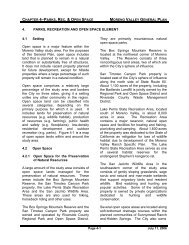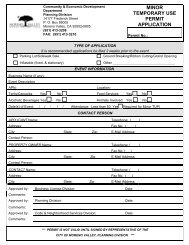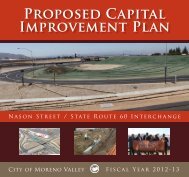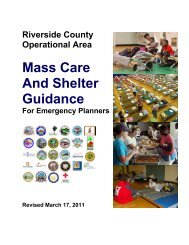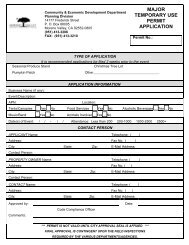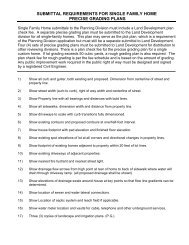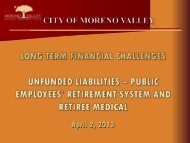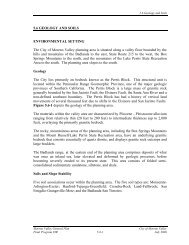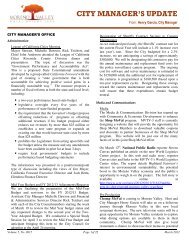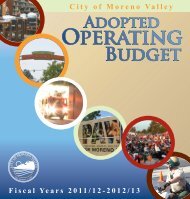General Plan - Moreno Valley
General Plan - Moreno Valley
General Plan - Moreno Valley
You also want an ePaper? Increase the reach of your titles
YUMPU automatically turns print PDFs into web optimized ePapers that Google loves.
CHAPTER 8 – HOUSINGMORENO VALLEY GENERAL PLANPolicy2.1.03ProgramIn order to meet the 1994 SCAG/RHNA figures of unmet needs (3,375 units ofvery low income housing, 4,023 units of low income housing and 3,287 units ofmoderate income housing, totaling 10,685 units) the City and RDA shall work tofacilitate the construction of 2,137 affordable units per year between 1990 and1995. As a minimum objective, the City and RDA shall work to construct,subsidize or facilitate the construction of one-third of this annual goal, an objectiveof 712 new affordable units per year. As a maximum goal, the City shall use2,137 units per year, the annual unmet need figure for low-moderate incomehousing, plus an additional 1,412 units per year at upper-income, or market-rateprices.The EDD/RDA will work with private developers and non-profit organizations toencourage the construction, rehabilitation and/or continued maintenance ofaffordable housing units that are appropriate to the needs of seniors, handicappedpersons, single parent and female-headed households, and large families, groupsthat are identified as being a significant numerical component of the <strong>Moreno</strong><strong>Valley</strong> population with special housing needs.UpdateAs the housing element was completed, the Southern California real estate market, and inparticular <strong>Moreno</strong> <strong>Valley</strong> suffered a significant decline. Real estate values and effective rentsdeclined as much as 20% and vacancy rates, in some projects, were as high as 50%.Foreclosures of both single and multi-family units increased. Growth in the Riverside-SanBernardino Statistical Area slowed significantly and the RHNA figures of unmet need seemedout of proportion in a rapidly declining economy.The decline in the market was dramatically reflected in the city’s construction permit activity.In the six years between 1986 and 1991, a total of 15,756 single and multi-family permitswere issued. In the six years between 1992 and 1997, a total of 1,562 single and multi-familypermits were issued, a 90% decrease in permit activity. The positive result of such adevastating decrease in construction activity was that new units being constructed wereaffordable to households with moderate incomes and existing resale units also becameaffordable to households at between 80% and 100% of median income.New construction was not economically feasible without large public subsidy. The Citycontinued to work with non-profit organizations, such as the Crippled Children’s Society,TELACU and Habitat for Humanity to develop housing for very low income and special needshouseholds. Additionally, the City continued to provide rehabilitation funds to assist in therehabilitation of existing and foreclosed units, both multi-family and single family, whichprovided affordable housing to low and very low income households. It is imperative to notethat the annual goal of 2,137 units established to meet the SCAG/RHNA figures, exceeded allnew construction during the six years of the housing element reporting time frame.Page 8-91 July 11, 2006




